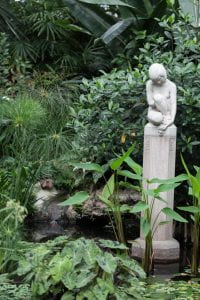An Embodiment of Empire: Lincoln Park Conservatory Revisited
Author: Qiyu Yang
Program of Study: Master of Arts Program in the Humanities (MAPH), Division of the Humanities (HUM)
A sense of tranquility embraces me when I virtually enter the Lincoln Park Conservatory. The first statue that comes into view – a girl in meditation – guides me to Arcadia. Taro leaves, papyrus and lotus growing out of the little pond create an illusion that I’m walking into a long-lost land. By showing its peacefulness and stillness, nature draws us temporarily away from the human world.

The Contemplative Statue Surrounded by Aquatic Plants. (Source: https://homesteadbrooklyn.com/all/2017/4/15/lincoln-park-conservatory-chicago)
It is officially acknowledged that this botanical garden was built within the trend of Chicagoans’ growing interest in collecting and categorizing plants to oppose the contemporary “ill effect of industrialization.”[1] Indeed, this explanation, which potentially implies a dichotomy between nature and culture, might be one of the most convincing understandings of the emergence of the Lincoln Park Conservatory. Even the decoration of the conservatory itself reinforces people’s preconceived idea that it was built as an idyllic vision of unspoiled wilderness against the bustling, competitive, depraved modern life: the exuberant Xanadu Philodendron contrasts with the rusty, corroded industrial components. Through exposing the fragility of the industrial world, revealing the immortality of nature, the decorator seems to declare the victory of the natural world. However, the buildings and skyscrapers not far away only expose the loneliness of the garden.

Xanadu Philodendron vs a Machine’s Metal Component. (Source: https://homesteadbrooklyn.com/all/2017/4/15/lincoln-park-conservatory-chicago)
It reminds me of Arcadia, where a solidary is situated in an idyllic ambiance. Studying and working in modern-day city, where men suffer from a fracture of nature, I am thrilled to find myself plunge into a utopian filled with plants and flowers. But “Et in Arcadia Ego”- even in Arcadia, there is death. The utopian imagination of the Golden Age, when human beings lived without the ambition to conquer other regions, held a close connection to nature, is doomed to fail. In this sense, the loneliness of the garden generated by its incompatibility to the metropolis make it seem out of place. Similarly, people also think of Arcadia in a mood of retrospection. The enigmatic tomb inscription is conventionally understood as an expression of “elegiac melancholy,” “a romantic device to emphasize the transience of life”,[2] a place that allures human beings’ desire to get close to the Golden Age, and excludes them, finally.

Nicolas Poussin, Et in Arcadia Ego (deuxième version). (Source: https://en.wikipedia.org/wiki/Et_in_Arcadia_ego_%28Poussin%29#/media/File:Nicolas_Poussin_-_Et_in_Arcadia_ego_(deuxi%C3%A8me_version).jpg)
Beneath the smooth surface of the tranquility, escapism, and nostalgia, however, I find powerful undercurrents. Opened in 1892, simply a year before the World Columbian Exposition, the garden was, I suspect, utilized as a means to expose Chicago achievements of industrialization and to glorify America as an all-encompassing empire. Following other famous gardens such as the Royal Botanic Gardens at Kew which shows Britain’s identity as an empire[3], Americans created their own garden that displayed their mastery of the natural world by collecting, categorizing, and organizing exotic plants. Plants across the world were collected and transported to Chicago for the purpose of celebrating the newly-emerging world center. The American empire, rather than simply ruled by military power and economic expansion, was more delicately furnished by mastering knowledge on natural history, speciology, and taxonomy.
To understand the botanical garden as a component of the World’s Columbian Exposition also compel us to reconsider how “natural” it really is. A conservatory is in itself a human-creation, aiming at controlling natural endowments such as temperature, humidity, and sunlight. Chicagoans not only transplanted diverse tropical plants to the windy city but also utilized the abundant evergreen plants to assure people that “no matter the time of year, visitors can feast both eyes and noses alike on a vast array of fruits and blooms representing all corners of the globe”[4]. Via reversing the natural order between hotness and coldness, transforming the conventional time and space, Chicagoans were proudly creating their “second nature,” the artificial nature that people erected atop the original, pre-human nature according to Hegel and Marx.

A Kigalia Africana, native to Mozambique. (Source: https://homesteadbrooklyn.com/all/2017/4/15/lincoln-park-conservatory-chicago)
Second, it is impossible to accomplish the construction of the conservatory, the searching for species around the globe, and the plant-transporting without the “improvement” of industrial technology and human knowledge. Without the early nineteenth century developments in iron and glass building technology, the design of conservatory simply could not come into being. Without the efforts of making Chicago as the new center of channels and railroads[5], and the ambition of making America as the new world-empire, different species scattered all over the world could not be transported to Chicago. Without the Columbian determination of understanding, conquering, and arranging the lands across the ocean, it was hard to imagine the necessity of constructing a world-embracing botanical and taxonomic system. To simply regard the botanical garden as a negation of industrialization, a celebration to pre-human nature might ignore the ambition and will of a newly-emerging industrialized empire.
Rather than casting a retrospective glance towards the past, the construction of the garden portends American optimism towards the future. This optimism towards the future can be positioned into several broader, historical contexts. First, in the Great Fire of October 8-9, 1871, when whole city blocks were engulfed in blaze and agony. However, the destruction of the old city also brought resurrection to Chicago: nearly every part of the city was under rearrangement and creation. Only two decades later, Chicago, as a phoenix that burns itself and then rises from its ashes, accomplished its transformation and held the exposition aimed at encompassing the world. [6] Second, American’s strong belief in man-made creation not only lay in their individual living experience, but also deeply rooted in their belief in the Age of Discovery: it was not until human beings decided to leave the boundaries of their motherland and navigate the seas, could America itself be discovered. Through exposing the all-inclusive capacity of the World’s Columbian Exposition, Americans were hoping for their nation’s future distinctive greatness.

Looking West from Peristyle, Court of Honor and Grand Basin of the 1893 World’s Columbian Exposition (Chicago, Illinois). (Source: https://fineartamerica.com/featured/chicago-worlds-fair-the-white-city-1893-war-is-hell-store.html?product=greeting-card)
What is more, contrary to the conventional understanding, I find in the classical period, people understood Arcadia from a completely different perspective. In ancient Greece, Arcadia was a land that was dominated by Orphic mysteries. The Orphic adherents were required to pass through the tombs, abnegating their painful past and embracing their rebirth. In other words, Arcadia was not comprehended as a lost haven triggered by men’s nostalgia towards nature, but in itself an optimistic future that needed to be realized by human beings. Hundreds of years later, when Virgil compares Rome as Arcadia, he intended to call upon Romans to renounce their civic wars’ discord, and reunite under Augustus to fulfill their destiny of making a world empire.[7] Deeply rooted in the origin of Western civilization, Arcadia was not a long lost natural landscape, but a signal that called upon human strength, power and will to create a future world empire.
Is America the New Greece and Rome? I don’t know. But Chicagoans, the “phoenix” who gained its rebirth from the ashes, Americans, who carries on the spirit of the Age of Discovery which always negates its limitations and looks forward to the future, constantly remind me of the people who pass through the Arcadian tomb to embrace their regeneration. Revisiting Lincoln Park Conservatory, suddenly the turbulence and chaos triggered by an industrial empire all dawned upon me: her infinite force turns the wheels of trains thousands miles distant in tropical lands, her inexhaustible vigor compels the resistless subjugation of lakes and forests, her unlimited optimism towards the future make everyone in the world to witness the creation of an empire.
Reference:
[1] https://www.chicagoparkdistrict.com/parks-facilities/lincoln-park-conservatory
[2] Morris R. Brownell, Alexander Pope and the Arts of Georgian England, Oxford: Clarendon Press, 1977, p. 144. Coffin, The English Garden: Meditation and Memorial, p. 27.
[3] For a detailed study of this topic, see Richard Drayton, Nature’s Government: Science, Imperial Britain, and the “improvement” of the world, New Haven and London: Yale University Press, 2000.
[4] https://www.facebook.com/LincolnParkConservatory/.
[5] For a complex study of how the construction of rails and channels made Chicago the center of the Great West, see William Cronon, Nature’s Metropolis: Chicago and the Great West, New York and London: W. W. Norton & Company, 1991, pp. 55-81.
[6] Ibid, pp. 345-350.
[7] Eva Anagnostou-Laoutides, “Ancient Ritual and the Search for Arcadia: From Virgil to Poussin,” Transcultural Studies, no. 2-3, 2006-2007.

Leave a Reply
You must be logged in to post a comment.